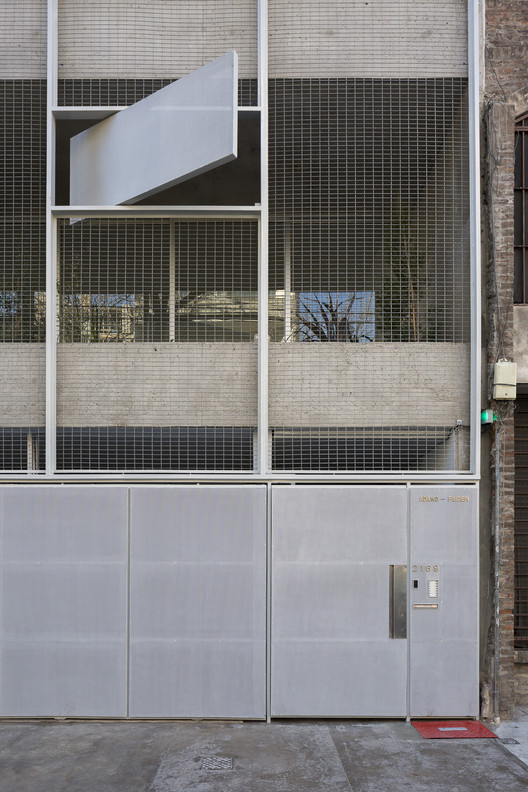Conversion of Castel Mirabel in Olgiasca Met Architektur
2013-12-24 01:00
架构师提供的文本描述。卡塞尔米拉贝尔,坐落在皮奥纳半岛历史中心的最高点,其地基可追溯到13世纪,1975年由业主购买并改装。2008年,它被卖给了新主人。
Text description provided by the architects. The CastelMirabel, sited on the highest point of the historic centre of Olgiasca, on the Piona peninsula, and whose foundations date from the 13th century, was purchased and converted in1975 by the owner at the time. It was sold to the new owner in 2008.
目前项目的动力是打算将设想为一个单元的建筑物分成两个完全独立的住宅。每个住宅都有一个单独的入口和自己的露台。在地势较低的东南角,从狭窄的街道到东露台建立了一条新的直接通道。
The impetus for the current project was the intention to divide the building, conceived as a single unit, into two completely separate residences. Each residence received a separate entrance and its own terrace. At the Southeast, topographically-lowed corner of the property, a new direct access was created from the narrow street to the East terrace.
在大楼的西北角有一个可切换的单元作为补充,并有自己的直接接入,使第三个单元成为第三个单元。这包括一个卧室和浴室,可以连接到任何一个其他住宅,或可以用来连接这两个住宅在一起。底层和东部露台上的房间可供整个房子使用,如果需要,甚至可以作为第四个单元使用。这种空间概念允许建筑物在多种灵活的配置中使用。
The offer is complemented by a switchable unit at the Northwest corner of the building with its own direct access, making a third unit. This consists of a bedroom and bathroom which can be connected to either of the other residences, or which can be used to link the two residences together. The rooms on the lower level and the East terrace are available to the entire house and can, if required, even function as a fourth unit. This spatial concept allows the building to be used in a wide variety of flexible configurations.
安装慷慨的浴室和厨房使以前最低限度的卫生设施符合现代对潮湿房间的要求。根据精确的计划对现有的房间进行了改造,以便将它们连接起来,并在整个建筑和每个主要方向建立视线。拆除上层过时的阁楼,打开了屋顶空间的巨大高度,作为内部空间的一部分。
The installation of generous bathrooms and kitchens has brought the previously minimal sanitary facilities in line with modern requirements for wet rooms. The existing rooms were modified according to precise plans in order to interconnect them and to create sightlines throughout the building and in every cardinal direction. The removal of the obsolete loft in the upper level opens up the massive height of the roof space as part of the internal space.
在改造之前,这座建筑具有高度内向和封闭的特点。房间相当黑暗,除了塔楼的房间外,内部和南方的令人叹为观止的景色之间完全没有任何联系。采取多种措施,加强了内外空间的关系。在南边,面对景色,新的窗户打开,现有的洞口被扩大,变成法国门,使每一层都能俯瞰湖面。新的入口楼梯也改善了从周围村庄街道到房子的可达性。
Before the conversion the building had a highly introverted and closed character. The rooms were rather dark and, with the exception of the tower room, there was absolutely no connection between the interior and the breath-taking view to the South. The relationship between the interior and exterior spaces was strengthened using various measures. On the Southern side, facing the view, new windows were opened and existing openings were enlarged and turned into French doors, giving each level a view over the lake. The new entry stairs also improved accessibility to the house from the surrounding village streets.
另一个重点的转换是结构改造的广泛潮湿损害。主要的翻新措施是安装供暖系统、绝缘灰泥、更换所有窗户、新防水、隔热和屋顶盖、新屋顶排水、沿较低层正面排水以及安装与地面接触的所有部件的凸起地板。对现有的天然石材砌体进行了外部清洗,并更换了损坏的接缝。
A further focus of the conversion is the structural renovation of the extensive damp damage. The main renovation measures were the installation of a heating system, insulating plaster, the replacement of all windows, new waterproofing, heat insulation and covering of the roof, new roof drainage, drainage along the facades of the lower level and the installation of raised flooring for all components in contact with the ground. The existing natural stone masonry was cleaned externally and damaged joins were replaced.
非常小心的发展细节屋顶排水和结构健全和水密连接之间的窗户和砖石。这些细节的安排,是为了保留建筑物的重要建筑特色。例如,对于有限的屋顶上盖和页岩屋顶,排水沟被整合到屋顶表面,以便从下面的街道上看不见。此外,还使用了抹灰窗边、屋檐下的抹灰条和单面百叶窗,使建筑物看起来比装修前更高贵、更有个性。这完善了建筑的建筑陈述,强化了建筑作为村庄结构的中心和决定性点的意义。
Great care was devoted to the development of the details for the roof drainage and the structurally-sound and watertight connection between the windows and masonry. These details were arranged in such a way as to preserve the significant architectural characteristics of the building. For the limited roof overhand and the shale roof covering, for example, the guttering was integrated into the roof surface so as to be invisible from the street below. In addition, the plastered window borders, the plastered strip under the roof overhang and the one-sided shutters were used to make the building appear nobler and more individual than before the renovation. This refined the building’s architectural statement and strengthened its significance as a central and defining point of the village’s structure.
 举报
举报
别默默的看了,快登录帮我评论一下吧!:)
注册
登录
更多评论
相关文章
-

描边风设计中,最容易犯的8种问题分析
2018年走过了四分之一,LOGO设计趋势也清晰了LOGO设计
-

描边风设计中,最容易犯的8种问题分析
2018年走过了四分之一,LOGO设计趋势也清晰了LOGO设计
-

描边风设计中,最容易犯的8种问题分析
2018年走过了四分之一,LOGO设计趋势也清晰了LOGO设计




































































